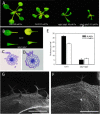Post-Transcriptional Coordination of the Arabidopsis Iron Deficiency Response is Partially Dependent on the E3 Ligases RING DOMAIN LIGASE1 (RGLG1) and RING DOMAIN LIGASE2 (RGLG2)
- PMID: 26253232
- PMCID: PMC4597148
- DOI: 10.1074/mcp.M115.048520
Post-Transcriptional Coordination of the Arabidopsis Iron Deficiency Response is Partially Dependent on the E3 Ligases RING DOMAIN LIGASE1 (RGLG1) and RING DOMAIN LIGASE2 (RGLG2)
Abstract
Acclimation to changing environmental conditions is mediated by proteins, the abundance of which is carefully tuned by an elaborate interplay of DNA-templated and post-transcriptional processes. To dissect the mechanisms that control and mediate cellular iron homeostasis, we conducted quantitative high-resolution iTRAQ proteomics and microarray-based transcriptomic profiling of iron-deficient Arabidopsis thaliana plants. A total of 13,706 and 12,124 proteins was identified with a quadrupole-Orbitrap hybrid mass spectrometer in roots and leaves, respectively. This deep proteomic coverage allowed accurate estimates of post-transcriptional regulation in response to iron deficiency. Similarly regulated transcripts were detected in only 13% (roots) and 11% (leaves) of the 886 proteins that differentially accumulated between iron-sufficient and iron-deficient plants, indicating that the majority of the iron-responsive proteins was post-transcriptionally regulated. Mutants harboring defects in the RING DOMAIN LIGASE1 (RGLG1)(1) and RING DOMAIN LIGASE2 (RGLG2) showed a pleiotropic phenotype that resembled iron-deficient plants with reduced trichome density and the formation of branched root hairs. Proteomic and transcriptomic profiling of rglg1 rglg2 double mutants revealed that the functional RGLG protein is required for the regulation of a large set of iron-responsive proteins including the coordinated expression of ribosomal proteins. This integrative analysis provides a detailed catalog of post-transcriptionally regulated proteins and allows the concept of a chiefly transcriptionally regulated iron deficiency response to be revisited. Protein data are available via ProteomeXchange with identifier PXD002126.
© 2015 by The American Society for Biochemistry and Molecular Biology, Inc.
Figures











Similar articles
-
A lysine-63-linked ubiquitin chain-forming conjugase, UBC13, promotes the developmental responses to iron deficiency in Arabidopsis roots.Plant J. 2010 Apr;62(2):330-43. doi: 10.1111/j.1365-313X.2010.04150.x. Epub 2010 Jan 27. Plant J. 2010. PMID: 20113438
-
Arabidopsis RGLG2, functioning as a RING E3 ligase, interacts with AtERF53 and negatively regulates the plant drought stress response.Plant Physiol. 2012 Jan;158(1):363-75. doi: 10.1104/pp.111.189738. Epub 2011 Nov 17. Plant Physiol. 2012. PMID: 22095047 Free PMC article.
-
Ubiquitin lysine 63 chain forming ligases regulate apical dominance in Arabidopsis.Plant Cell. 2007 Jun;19(6):1898-911. doi: 10.1105/tpc.107.052035. Epub 2007 Jun 22. Plant Cell. 2007. PMID: 17586653 Free PMC article.
-
A hitchhiker's guide to the Arabidopsis ferrome.Plant Physiol Biochem. 2011 May;49(5):462-70. doi: 10.1016/j.plaphy.2010.12.001. Epub 2010 Dec 9. Plant Physiol Biochem. 2011. PMID: 21216153 Review.
-
The many facets of protein ubiquitination and degradation in plant root iron-deficiency responses.J Exp Bot. 2021 Mar 17;72(6):2071-2082. doi: 10.1093/jxb/eraa441. J Exp Bot. 2021. PMID: 32945865 Review.
Cited by
-
The Understanding of the Plant Iron Deficiency Responses in Strategy I Plants and the Role of Ethylene in This Process by Omic Approaches.Front Plant Sci. 2017 Jan 24;8:40. doi: 10.3389/fpls.2017.00040. eCollection 2017. Front Plant Sci. 2017. PMID: 28174585 Free PMC article. Review.
-
Systems-wide analysis of manganese deficiency-induced changes in gene activity of Arabidopsis roots.Sci Rep. 2016 Nov 2;6:35846. doi: 10.1038/srep35846. Sci Rep. 2016. PMID: 27804982 Free PMC article.
-
Endosomally Localized RGLG-Type E3 RING-Finger Ligases Modulate Sorting of Ubiquitylation-Mimic PIN2.Int J Mol Sci. 2022 Jun 17;23(12):6767. doi: 10.3390/ijms23126767. Int J Mol Sci. 2022. PMID: 35743207 Free PMC article.
-
The E3 ubiquitin ligase OsRGLG5 targeted by the Magnaporthe oryzae effector AvrPi9 confers basal resistance against rice blast.Plant Commun. 2023 Sep 11;4(5):100626. doi: 10.1016/j.xplc.2023.100626. Epub 2023 May 11. Plant Commun. 2023. PMID: 37177781 Free PMC article.
-
Scopoletin 8-Hydroxylase-Mediated Fraxetin Production Is Crucial for Iron Mobilization.Plant Physiol. 2018 May;177(1):194-207. doi: 10.1104/pp.18.00178. Epub 2018 Mar 20. Plant Physiol. 2018. PMID: 29559590 Free PMC article.
References
MeSH terms
Substances
LinkOut - more resources
Full Text Sources
Molecular Biology Databases

